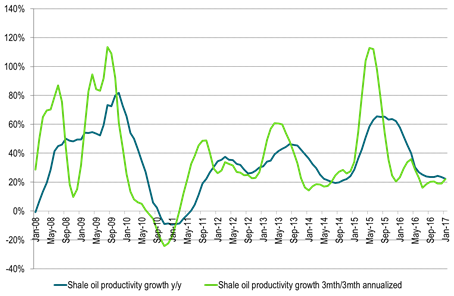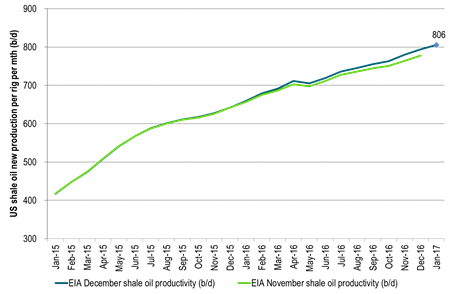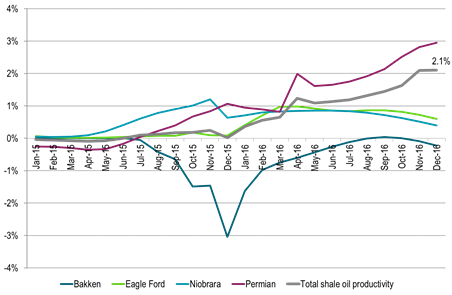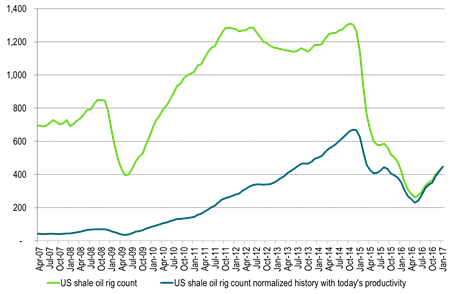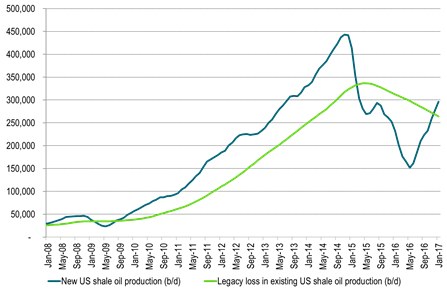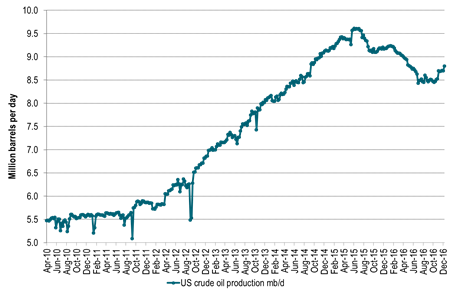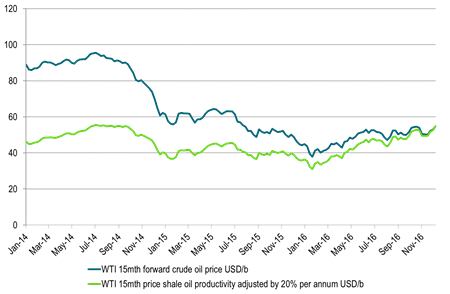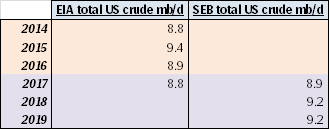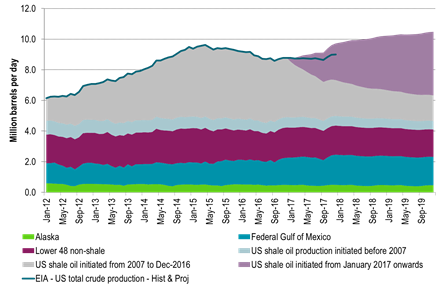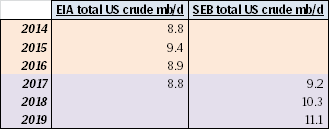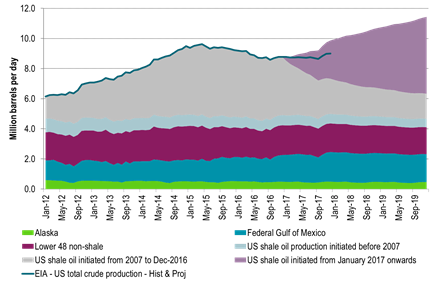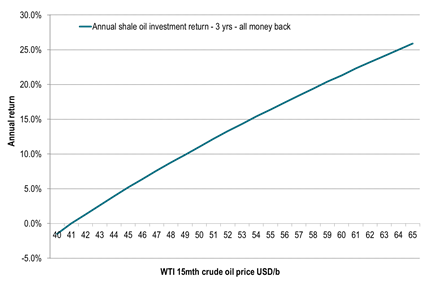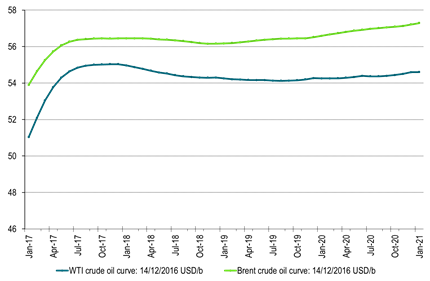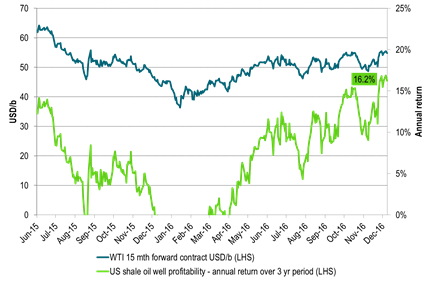Analys
US shale oil productivity update – OPEC could choke on strongly reviving US shale oil production in 2018 if oil prices hold up in H1-17

 Note: US rig count data by Baker Hughes at 19:00 CET on Friday December 16th
Note: US rig count data by Baker Hughes at 19:00 CET on Friday December 16th
Crude oil comment – US shale oil productivity update – OPEC likely to choke down the road on strongly reviving US shale oil production if oil prices hold up in H1-17
The only thing which can prevent a strong rise in US shale oil rig count going forward is muted crude oil prices. The physical crude oil production effect of an additional 25 shale oil rigs into the market per month in H1-17 won’t really hit the market before H2-17 and mostly 2018. Thus price action may stay oblivious to the coming wave of US shale oil production if it disregards a potentially continued solid rise in US shale oil rigs in H1-17 on the back of OPEC cuts and associated higher prices. At the moment we can see a marginal increase in US shale production projected for January 2017. In weekly data we can see that US crude production bottomed out in September and rose 99 kb/d w/w last week.
We will not see the actual realisation of US shale oil crude production in the spot market following the rig rise in H2-16 and potentially H1-17 for quite some time. I.e. not really before H2-17 and 2018. What we can see at the moment is the reflected hedging activity from the US shale oil players who hedge on the curve for 2018 and 2019 pushing it down. Shale oil players securing their investments in newly initiated activity having been burned heavily in the previous boom and bust. That is the immediate “shadow effect” hitting the market and the crude oil curve here and now as a reflection of the rising rig count which is again an effect of higher oil prices.
According to the latest US EIA’s Drilling productivity report there were 23 shale oil rigs added per month from the start of June until November. In November alone there were 34 rigs added.
The WTI 15mth price has averaged $51.6/b since the start of June. At the time of writing it trades at $54.3/b but recently traded all the way up to $56.4/b.
Note that in the below US crude oil production scenarios we have only assumed an additional 25 rigs per month for H1-17 for Ch10 and Ch11. That is not much more than the +23 added shale oil rigs per month since June observed by the US EIA in their December drilling productivity report. Thus assuming +25 rigs per month in H1-17 is not really acceleration in rig count addition versus H2-16. However, if the crude oil price was to be significantly higher, especially the WTI 15 mth crude price, then one probably should assume a substantially higher inflow of rigs in H1-17 than what we have witnessed in H2-16.
What this all tells us is that the oil price will be highly responsive to changes in the oil market balance versus OPEC cuts or whether Libyan production will average 1 mb/d in 2017 or just 0.5 mb/d or whether global oil demand growth will be much stronger or not in 2017 or whether Russia will actually be good on its pledged cuts for H1-17 etc. Then again US shale oil rig count and thereafter production will be highly responsive to oil prices again. We have shale oil boom and bust behind us. Now we have the shale oil adaptability before us. We cannot predict all the possible uncertain events which might hit the oil market supply/demand balance in 2017 and thus impact the oil price. We can however say a lot about the responsiveness for US shale oil production and thus how the oil market dynamically will behave. Thus if OPEC gives the market elevated oil prices in H1-17, then US shale oil will give the market a serious Blue Monday in H2-17 or 2018.
What the three US crude oil production scenarios below tells us is that US crude production in 2018 is highly impacted by how many rigs are added in H1-17. If there are no more rigs in H1-17, then US crude production is good at 9.2 mb/d in 2018. However, if we just continue on the trend from H2-16 with close to 25 extra rigs per month, then US crude production jumps to 10 mb/d in 2018. Thus the 2018 global supply/demand balance is really at play in H1-17. Our numbers are of course a model. The model still fairly well shows the magnitude of sensitivities at play.
Ch1: US shale oil volume productivity growth continues to hold up at 20% per annum
Both in terms of y/y as well as 3mth/3mth annualized
Ch2: US shale oil volume productivity set to rise to 806 b/d per rig per month in January
Calculated for the 4 main US shale oil regions: Bakken, Eagle Ford, Nibrara and Permian
Ch3: The US EIA again revised higher historical US shale oil productivity by 2.1% for Nov and Dec
Data back to December 2015 were also on average revised higher.
Ch4: The productive effect of today’s some 400 rigs are as strong as 1200 rigs back at the start of 2013
Dark line gives historical rig count adjusted with today’s productivity versus productivity at the time.
An additional 23 rigs are assumed added both in December and in January.
Ch5: US shale oil production is set to start to rise rapidly near term as new production cross above losses in old production
New production here given by EIA rig productivity (December report) stretching out to Jan-17 multiplied by rig count from same report but assuming an additional 23 rigs added in Dec and Jan. In reality however there is a time-lag of 2-4 months before they really cross over.
Ch6: US EIA shale oil production just about to turn higher
Data from EIA’s drilling productivity report for December
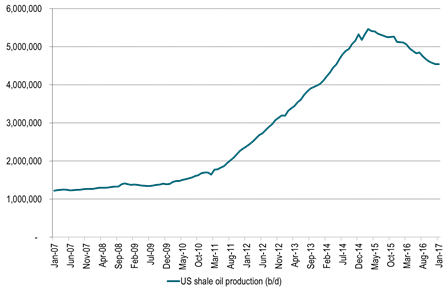 Ch7: US crude oil production in weekly data already ticking higher (+99 kb/d w/w last week)
Ch7: US crude oil production in weekly data already ticking higher (+99 kb/d w/w last week)
Ch8: US WTI15mth contract at most stimulative level (shale oil investment vise) since July 2015
Playing with numbers:
Green line: Adjust historical WTI15mth crude prices with the 20% pa (roughly) volume productivity growth
Then today’s WTI15 mth price is the most investment wise stimulative level since August 2014
Ch9: US 2018 crude oil production at 9.2 mb/d – Assuming no added US shale oil rigs after Nov 2016 and zero productivity growth
Thus rig count is fixed at 401 from Dec-16 onwards with no productivity growth
However we have already seen 21 additional shale oil rigs into the market in December but they are not added to this scenario.
Only the rigs from the US EIA’s December drilling productivity report are included in this scenario.
Thus seen in the perspective of SEB’s US crude oil model it seems to us that the US EIA assumes NO additional activated shale oil rigs into the market after Nov-16 and no additional shale oil rigs into market in 2017.
We think that the US EIA should specify its assumptions and model projections for the US shale oil rig cont and productivity which goes into their model in its monthly STEO oil reports.
Ch10: US 2018 crude oil production at 10.0 mb/d – Assuming +25 shale oil rigs per month from December 2016 to June-2017 and zero productivity growth
Then no more rigs added after June 2017 with number of US shale oil rigs fixed at 576 rigs after that
Also zero volume productivity growth here onwards from December 2016 gives the following production projection
Ch11: US 2018 crude oil production at 10.3 mb/d – Assuming +25 shale oil rigs per month from December 2016 to June-2017 and 10% pa volume productivity growth
Then no more rigs added after June 2017 with number of US shale oil rigs fixed at 576 rigs after that
But assume that US shale oil volume productivity growth continues at 10% pa. instead of the historical (and current) 20% pa.
Ch12: US shale oil profitability versus WTI 15 mth crude oil prices
Annual return for a three year investment.
Three years of crude oil production from a new shale oil well.
All money back after three years.
IP 1mth: 1000 b/d. Royalty pay: 20%. Discount rate: 10%, Three yr production after royalty and discount: 330,000 barrels, Wellhead to Cushing discount: $5/b, OPEX: $12/b, Total well cost: $8million,
All production within the hedgeable part of the WTI crude oil price curve.
Thus return should be possible to lock in at the initiation of the investment
Ch13: The WTI crude oil forward curve feeling the depression from shale oil hedging in 2018 and 2019
Likely to be increasingly heavy depression if rig count continues to rise further
Ch14: As three year annual shale oil profitability hits 16% pa
Kind regards
Bjarne Schieldrop
Chief analyst, Commodities
SEB Markets
Merchant Banking
Analys
Tightening fundamentals – bullish inventories from DOE

The latest weekly report from the US DOE showed a substantial drawdown across key petroleum categories, adding more upside potential to the fundamental picture.

Commercial crude inventories (excl. SPR) fell by 5.8 million barrels, bringing total inventories down to 415.1 million barrels. Now sitting 11% below the five-year seasonal norm and placed in the lowest 2015-2022 range (see picture below).
Product inventories also tightened further last week. Gasoline inventories declined by 2.1 million barrels, with reductions seen in both finished gasoline and blending components. Current gasoline levels are about 3% below the five-year average for this time of year.
Among products, the most notable move came in diesel, where inventories dropped by almost 4.1 million barrels, deepening the deficit to around 20% below seasonal norms – continuing to underscore the persistent supply tightness in diesel markets.
The only area of inventory growth was in propane/propylene, which posted a significant 5.1-million-barrel build and now stands 9% above the five-year average.
Total commercial petroleum inventories (crude plus refined products) declined by 4.2 million barrels on the week, reinforcing the overall tightening of US crude and products.


Analys
Bombs to ”ceasefire” in hours – Brent below $70

A classic case of “buy the rumor, sell the news” played out in oil markets, as Brent crude has dropped sharply – down nearly USD 10 per barrel since yesterday evening – following Iran’s retaliatory strike on a U.S. air base in Qatar. The immediate reaction was: “That was it?” The strike followed a carefully calibrated, non-escalatory playbook, avoiding direct threats to energy infrastructure or disruption of shipping through the Strait of Hormuz – thus calming worst-case fears.

After Monday morning’s sharp spike to USD 81.4 per barrel, triggered by the U.S. bombing of Iranian nuclear facilities, oil prices drifted sideways in anticipation of a potential Iranian response. That response came with advance warning and caused limited physical damage. Early this morning, both the U.S. President and Iranian state media announced a ceasefire, effectively placing a lid on the immediate conflict risk – at least for now.
As a result, Brent crude has now fallen by a total of USD 12 from Monday’s peak, currently trading around USD 69 per barrel.
Looking beyond geopolitics, the market will now shift its focus to the upcoming OPEC+ meeting in early July. Saudi Arabia’s decision to increase output earlier this year – despite falling prices – has drawn renewed attention considering recent developments. Some suggest this was a response to U.S. pressure to offset potential Iranian supply losses.
However, consensus is that the move was driven more by internal OPEC+ dynamics. After years of curbing production to support prices, Riyadh had grown frustrated with quota-busting by several members (notably Kazakhstan). With Saudi Arabia cutting up to 2 million barrels per day – roughly 2% of global supply – returns were diminishing, and the risk of losing market share was rising. The production increase is widely seen as an effort to reassert leadership and restore discipline within the group.
That said, the FT recently stated that, the Saudis remain wary of past missteps. In 2018, Riyadh ramped up output at Trump’s request ahead of Iran sanctions, only to see prices collapse when the U.S. granted broad waivers – triggering oversupply. Officials have reportedly made it clear they don’t intend to repeat that mistake.
The recent visit by President Trump to Saudi Arabia, which included agreements on AI, defense, and nuclear cooperation, suggests a broader strategic alignment. This has fueled speculation about a quiet “pump-for-politics” deal behind recent production moves.
Looking ahead, oil prices have now retraced the entire rally sparked by the June 13 Israel–Iran escalation. This retreat provides more political and policy space for both the U.S. and Saudi Arabia. Specifically, it makes it easier for Riyadh to scale back its three recent production hikes of 411,000 barrels each, potentially returning to more moderate increases of 137,000 barrels for August and September.
In short: with no major loss of Iranian supply to the market, OPEC+ – led by Saudi Arabia – no longer needs to compensate for a disruption that hasn’t materialized, especially not to please the U.S. at the cost of its own market strategy. As the Saudis themselves have signaled, they are unlikely to repeat previous mistakes.
Conclusion: With Brent now in the high USD 60s, buying oil looks fundamentally justified. The geopolitical premium has deflated, but tensions between Israel and Iran remain unresolved – and the risk of missteps and renewed escalation still lingers. In fact, even this morning, reports have emerged of renewed missile fire despite the declared “truce.” The path forward may be calmer – but it is far from stable.
Analys
A muted price reaction. Market looks relaxed, but it is still on edge waiting for what Iran will do

Brent crossed the 80-line this morning but quickly fell back assigning limited probability for Iran choosing to close the Strait of Hormuz. Brent traded in a range of USD 70.56 – 79.04/b last week as the market fluctuated between ”Iran wants a deal” and ”US is about to attack Iran”. At the end of the week though, Donald Trump managed to convince markets (and probably also Iran) that he would make a decision within two weeks. I.e. no imminent attack. Previously when when he has talked about ”making a decision within two weeks” he has often ended up doing nothing in the end. The oil market relaxed as a result and the week ended at USD 77.01/b which is just USD 6/b above the year to date average of USD 71/b.

Brent jumped to USD 81.4/b this morning, the highest since mid-January, but then quickly fell back to a current price of USD 78.2/b which is only up 1.5% versus the close on Friday. As such the market is pricing a fairly low probability that Iran will actually close the Strait of Hormuz. Probably because it will hurt Iranian oil exports as well as the global oil market.
It was however all smoke and mirrors. Deception. The US attacked Iran on Saturday. The attack involved 125 warplanes, submarines and surface warships and 14 bunker buster bombs were dropped on Iranian nuclear sites including Fordow, Natanz and Isfahan. In response the Iranian Parliament voted in support of closing the Strait of Hormuz where some 17 mb of crude and products is transported to the global market every day plus significant volumes of LNG. This is however merely an advise to the Supreme leader Ayatollah Ali Khamenei and the Supreme National Security Council which sits with the final and actual decision.
No supply of oil is lost yet. It is about the risk of Iran closing the Strait of Hormuz or not. So far not a single drop of oil supply has been lost to the global market. The price at the moment is all about the assessed risk of loss of supply. Will Iran choose to choke of the Strait of Hormuz or not? That is the big question. It would be painful for US consumers, for Donald Trump’s voter base, for the global economy but also for Iran and its population which relies on oil exports and income from selling oil out of that Strait as well. As such it is not a no-brainer choice for Iran to close the Strait for oil exports. And looking at the il price this morning it is clear that the oil market doesn’t assign a very high probability of it happening. It is however probably well within the capability of Iran to close the Strait off with rockets, mines, air-drones and possibly sea-drones. Just look at how Ukraine has been able to control and damage the Russian Black Sea fleet.
What to do about the highly enriched uranium which has gone missing? While the US and Israel can celebrate their destruction of Iranian nuclear facilities they are also scratching their heads over what to do with the lost Iranian nuclear material. Iran had 408 kg of highly enriched uranium (IAEA). Almost weapons grade. Enough for some 10 nuclear warheads. It seems to have been transported out of Fordow before the attack this weekend.
The market is still on edge. USD 80-something/b seems sensible while we wait. The oil market reaction to this weekend’s events is very muted so far. The market is still on edge awaiting what Iran will do. Because Iran will do something. But what and when? An oil price of 80-something seems like a sensible level until something do happen.
-

 Nyheter3 veckor sedan
Nyheter3 veckor sedanStor uppsida i Lappland Guldprospekterings aktie enligt analys
-

 Nyheter4 veckor sedan
Nyheter4 veckor sedanBrookfield ska bygga ett AI-datacenter på hela 750 MW i Strängnäs
-

 Nyheter3 veckor sedan
Nyheter3 veckor sedanSilverpriset släpar efter guldets utveckling, har mer uppsida
-

 Nyheter4 veckor sedan
Nyheter4 veckor sedanTradingfirman XTX Markets bygger datacenter i finska Kajana för 1 miljard euro
-

 Nyheter2 veckor sedan
Nyheter2 veckor sedanUppgången i oljepriset planade ut under helgen
-

 Nyheter2 veckor sedan
Nyheter2 veckor sedanLåga elpriser i sommar – men mellersta Sverige får en ökning
-

 Analys2 veckor sedan
Analys2 veckor sedanVery relaxed at USD 75/b. Risk barometer will likely fluctuate to higher levels with Brent into the 80ies or higher coming 2-3 weeks
-

 Nyheter1 vecka sedan
Nyheter1 vecka sedanMahvie Minerals växlar spår – satsar fullt ut på guld


